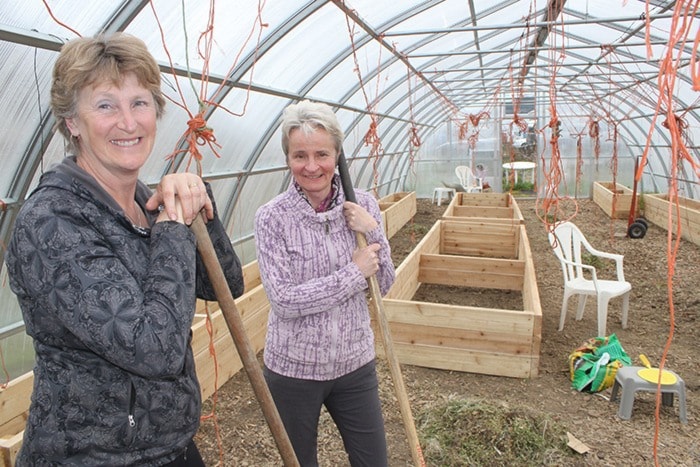Community Food organizers and local farmers Diana Penner and Agatha Jedrzejczyk hope that Terrace can revive its past as a major farming community and create an economy where being a farmer is a legitimate career.
“My vision is to have 10 big farms producing for Terrace for people who live in Terrace and which we buy our produce from to secure our future,” says Jedrzejczyk who runs the Kalum Community School Society, an organization that supports several local food programs.
Among those programs is an organic farming initiative spearheaded by Diana Penner called Community Supports Agriculture (CSA). In return for a lump sum paid in advance, participants receive approximately five months worth of weekly produce and other foods during the growing and harvest season.
Penner grew up on a 30-acre farm located on the rich ground of Braun’s Island, and has returned to take up the hoe again.
Decades ago she says Terrace had several larger farms both in the Horseshoe and by the Skeena. Looser agricultural rules allowed farmers to ship out their produce on trains to other markets.
Down by the Skeena the natural irrigation works somewhat like a Canadian Nile Delta and the resulting alluvial soils allow farmers to grow all kinds of produce that formed a major source of local staples such as potatoes and cabbage and also fruit on trees which still exist today.
The provincial government notes the productivity of Terrace land and the city’s planning maps show large areas zoned for farming that are currently fallow.
The Greater Terrace Agricultural Plan which came out in 2013 details the exact amount of land and the location and one of its authors Norma Kerby described the area as a major farming centre prior to the upswing in forestry in the late 1940’s.
According to the provincial government, “the greater Terrace area enjoys growing conditions that are very favourable to the production of: broccoli, cauliflower, cabbage, and root crops such as carrots, beets, turnips, and also leafy greens such as lettuce, spinach, kale, chard. Peas and potatoes also do well.”
Today, most area farmers are small hobbyists who sell at the Skeena Valley Farmers Market on Saturdays, says Penner.
There’s a larger growing enterprise, the Bahr Farm in Old Remo, which also sells at the market.
Penner’s Community Supports Agriculture box distribution is based on a model that has been successful in countries such as Poland where economic hardship following the end of the Soviet empire forced communities to be self-reliant. Penner grows most herself and also purchases from other local growers for market prices. Last year, she provided 51 different products for a $500 fee. People receive one box of produce a week from June through October.
The enterprise lost money last year. In the second year, there were 13 clients, then last year Penner hit 51. At 60 boxes she thinks she would break even and have some money to hire an assistant.
But if a farmer could have 200 clients, then he or she would be able to make $25,000 a season which starts to resemble something like a career, Jedrzejczyk calculates.
On paper, the system seems to be a way forward to those wishing to reclaim local farming as a career and Penner is forging ahead to try to prove that it can be done.
Jedrzejczyk, who learned about box systems growing up in Poland, said the ongoing drought in California is all the more reason for people to be concerned about the rising prices she has noticed when buying food for another program she runs, the Good Food Box.
“We may be cut off from the food from the South; everybody knows California is short of water. And it looks like we will have more rain here than ever, so it looks like we are going to be the land with water. It’s my dream to export lettuce to California,” said Jedrzejczyk.
“The benefits and increasing necessity of a locally sustainable food economy are widely documented," said Penner, adding that the physical challenges still deter most people. "From a reduction in transportation emissions, increased freshness, to the security of not relying on a global system which balanced precariously in a shifting environmental landscape and creating local jobs, the benefits are palpable."
Penner also acknowledges that attracting younger people to a farming career is still a challenge.
“We recognize a need for more community, she said. “The old farmers are now old farmers. How do you encourage people to become farmers again? Technically, we could feed the whole town."
